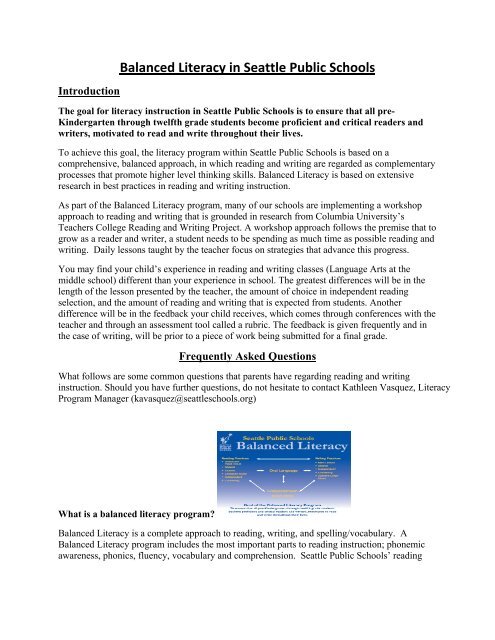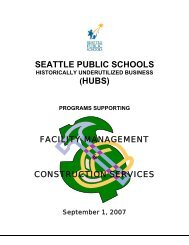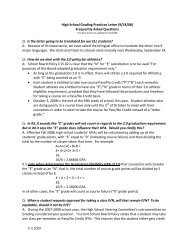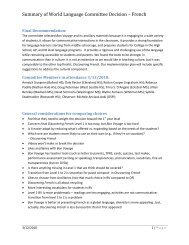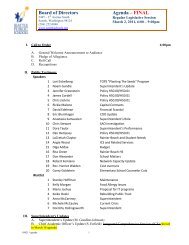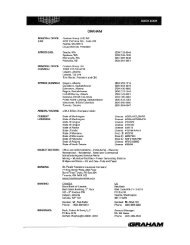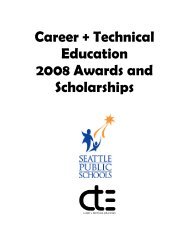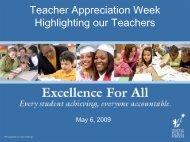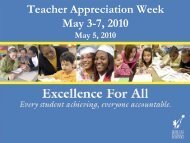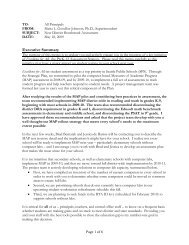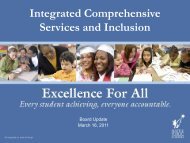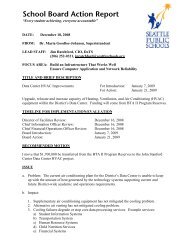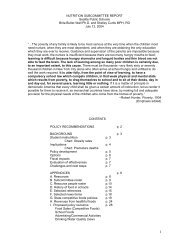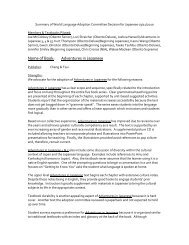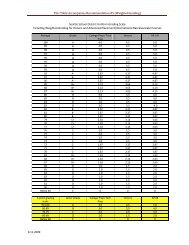Balanced Literacy in Seattle Public Schools
Balanced Literacy in Seattle Public Schools
Balanced Literacy in Seattle Public Schools
Create successful ePaper yourself
Turn your PDF publications into a flip-book with our unique Google optimized e-Paper software.
Introduction<br />
<strong>Balanced</strong> <strong>Literacy</strong> <strong>in</strong> <strong>Seattle</strong> <strong>Public</strong> <strong>Schools</strong><br />
The goal for literacy <strong>in</strong>struction <strong>in</strong> <strong>Seattle</strong> <strong>Public</strong> <strong>Schools</strong> is to ensure that all pre-<br />
K<strong>in</strong>dergarten through twelfth grade students become proficient and critical readers and<br />
writers, motivated to read and write throughout their lives.<br />
To achieve this goal, the literacy program with<strong>in</strong> <strong>Seattle</strong> <strong>Public</strong> <strong>Schools</strong> is based on a<br />
comprehensive, balanced approach, <strong>in</strong> which read<strong>in</strong>g and writ<strong>in</strong>g are regarded as complementary<br />
processes that promote higher level th<strong>in</strong>k<strong>in</strong>g skills. <strong>Balanced</strong> <strong>Literacy</strong> is based on extensive<br />
research <strong>in</strong> best practices <strong>in</strong> read<strong>in</strong>g and writ<strong>in</strong>g <strong>in</strong>struction.<br />
As part of the <strong>Balanced</strong> <strong>Literacy</strong> program, many of our schools are implement<strong>in</strong>g a workshop<br />
approach to read<strong>in</strong>g and writ<strong>in</strong>g that is grounded <strong>in</strong> research from Columbia University’s<br />
Teachers College Read<strong>in</strong>g and Writ<strong>in</strong>g Project. A workshop approach follows the premise that to<br />
grow as a reader and writer, a student needs to be spend<strong>in</strong>g as much time as possible read<strong>in</strong>g and<br />
writ<strong>in</strong>g. Daily lessons taught by the teacher focus on strategies that advance this progress.<br />
You may f<strong>in</strong>d your child’s experience <strong>in</strong> read<strong>in</strong>g and writ<strong>in</strong>g classes (Language Arts at the<br />
middle school) different than your experience <strong>in</strong> school. The greatest differences will be <strong>in</strong> the<br />
length of the lesson presented by the teacher, the amount of choice <strong>in</strong> <strong>in</strong>dependent read<strong>in</strong>g<br />
selection, and the amount of read<strong>in</strong>g and writ<strong>in</strong>g that is expected from students. Another<br />
difference will be <strong>in</strong> the feedback your child receives, which comes through conferences with the<br />
teacher and through an assessment tool called a rubric. The feedback is given frequently and <strong>in</strong><br />
the case of writ<strong>in</strong>g, will be prior to a piece of work be<strong>in</strong>g submitted for a f<strong>in</strong>al grade.<br />
Frequently Asked Questions<br />
What follows are some common questions that parents have regard<strong>in</strong>g read<strong>in</strong>g and writ<strong>in</strong>g<br />
<strong>in</strong>struction. Should you have further questions, do not hesitate to contact Kathleen Vasquez, <strong>Literacy</strong><br />
Program Manager (kavasquez@seattleschools.org)<br />
What is a balanced literacy program?<br />
<strong>Balanced</strong> <strong>Literacy</strong> is a complete approach to read<strong>in</strong>g, writ<strong>in</strong>g, and spell<strong>in</strong>g/vocabulary. A<br />
<strong>Balanced</strong> <strong>Literacy</strong> program <strong>in</strong>cludes the most important parts to read<strong>in</strong>g <strong>in</strong>struction; phonemic<br />
awareness, phonics, fluency, vocabulary and comprehension. <strong>Seattle</strong> <strong>Public</strong> <strong>Schools</strong>’ read<strong>in</strong>g
program <strong>in</strong>cludes researched-based practices of read aloud, shared read<strong>in</strong>g, guided read<strong>in</strong>g, and<br />
<strong>in</strong>dependent read<strong>in</strong>g.<br />
The writ<strong>in</strong>g process <strong>in</strong>cludes gather<strong>in</strong>g ideas, plann<strong>in</strong>g, draft<strong>in</strong>g, edit<strong>in</strong>g, and publish<strong>in</strong>g writ<strong>in</strong>g<br />
pieces. At various times, students will be <strong>in</strong>volved <strong>in</strong> shared writ<strong>in</strong>g, <strong>in</strong>teractive writ<strong>in</strong>g, and<br />
<strong>in</strong>dependent writ<strong>in</strong>g. In order to expand the students ability to work effectively with words, we<br />
<strong>in</strong>corporate word study practices that <strong>in</strong>clude a developmental approach to learn<strong>in</strong>g about how<br />
words are made up, the various mean<strong>in</strong>gs of words, and, <strong>in</strong> later grades, word orig<strong>in</strong>s.<br />
Where can I f<strong>in</strong>d the grade level standards for language arts?<br />
The Wash<strong>in</strong>gton State Office of <strong>Public</strong> Instruction determ<strong>in</strong>es the Grade Level Standards. Click<br />
here to f<strong>in</strong>d out about the expectations at a particular grade level. Our literacy programs<br />
correlate with the state standards and will match the newly released National Core Curricular<br />
Standards before implementation is required. To f<strong>in</strong>d out more about the National Core<br />
Curricluar Standards click here.<br />
What is Writ<strong>in</strong>g Workshop?<br />
Writ<strong>in</strong>g Workshop has three basic structures:<br />
the m<strong>in</strong>i-lesson<br />
<strong>in</strong>dependent writ<strong>in</strong>g time when the teacher is conferr<strong>in</strong>g and/or work<strong>in</strong>g with small<br />
groups, and<br />
share-sessions at the end of the writ<strong>in</strong>g time.<br />
These structures support best practices <strong>in</strong> writ<strong>in</strong>g <strong>in</strong>struction by provid<strong>in</strong>g direct <strong>in</strong>struction,<br />
expos<strong>in</strong>g students to examples of quality writ<strong>in</strong>g, guided practice as students beg<strong>in</strong> try<strong>in</strong>g their<br />
hand at the new learn<strong>in</strong>g, and f<strong>in</strong>ally <strong>in</strong>dependent use of the strategies by the student (Vygotsky,<br />
1978).<br />
The foundation of Writers Workshop is based on the understand<strong>in</strong>g that writ<strong>in</strong>g is a life-long<br />
process dur<strong>in</strong>g which we cont<strong>in</strong>ually lift the level of our writ<strong>in</strong>g skills and outgrow ourselves as<br />
writers. Students learn that all writ<strong>in</strong>g has essential traits to which they must attend when<br />
develop<strong>in</strong>g a piece (Spandel, 2001). Writers learn multiple ways to f<strong>in</strong>d topics they wish to write<br />
about, they learn to make very purposeful decisions about the structure and organization of a<br />
piece, they learn a repertoire of methods for elaborat<strong>in</strong>g (us<strong>in</strong>g description to enhance their<br />
writ<strong>in</strong>g), they learn to craft their pieces of writ<strong>in</strong>g by us<strong>in</strong>g literary language and devices, and<br />
they learn to employ the conventions of written language (Anderson, 2005; Calk<strong>in</strong>s, 1994;<br />
Elbow, 1989;Graves, 1994; Wood Ray, 1999).<br />
Just as professional writers have a process for develop<strong>in</strong>g their work, young apprentice writers<br />
also benefit from a clear process through which to develop their writ<strong>in</strong>g. (Atwell, 1998; Calk<strong>in</strong>s,<br />
1994; Elbow, 1981; Fletcher, 1993; Graves, 1994; Murray, 1984)
Each unit <strong>in</strong> the Units of Study for Writ<strong>in</strong>g beg<strong>in</strong>s with generat<strong>in</strong>g ideas for writ<strong>in</strong>g. When<br />
writers have collected a number of possibilities, they learn ways to choose one idea and beg<strong>in</strong><br />
develop<strong>in</strong>g and rehears<strong>in</strong>g that idea to prepare for the specific genre <strong>in</strong> which they will be<br />
writ<strong>in</strong>g. They learn how to draft us<strong>in</strong>g the structure and elaboration techniques that apply to that<br />
genre. Writers then learn ways to revise their writ<strong>in</strong>g us<strong>in</strong>g structure, elaboration, and literary<br />
craft moves to further reveal their mean<strong>in</strong>g. Next, writers learn to edit their pieces by employ<strong>in</strong>g<br />
the conventions of written language. F<strong>in</strong>ally, writers publish their work to share with a<br />
community – either their class, their school community, or a community outside their school.<br />
Research shows that us<strong>in</strong>g a writ<strong>in</strong>g process for <strong>in</strong>struction <strong>in</strong> the complex task of writ<strong>in</strong>g,<br />
<strong>in</strong>creases student achievement (Hillocks, 1986; Holdzkom, Reed, Porter, & Rub<strong>in</strong>, 1982; Keech<br />
& Thomas, 1979).<br />
(Excerpt from Calk<strong>in</strong>s, Lucy (2006) Units of Study, Grades 3-5. He<strong>in</strong>emann. Portsmouth, NH.)<br />
How is grammar <strong>in</strong>struction addressed <strong>in</strong> WW?<br />
Students are taught that writers make decisions about grammar (structural rules of sentences,<br />
phrases, and words) to more clearly communicate to the reader. Instruction occurs <strong>in</strong> wholegroup,<br />
<strong>in</strong> small strategy groups, and <strong>in</strong> <strong>in</strong>dividual conferences. Teachers make decisions about<br />
which conventions to address based on the grade level standards and what each student is<br />
approximat<strong>in</strong>g. Our <strong>in</strong>struction is designed to arm each writer with the grammar skills they need<br />
to develop as a writer.<br />
Grammar <strong>in</strong>struction is most effective <strong>in</strong> the context of read<strong>in</strong>g and writ<strong>in</strong>g. While teachers use<br />
appropriate grammar vocabulary to describe conventions, students are assessed <strong>in</strong> the appropriate<br />
use of conventions.<br />
How do students receive <strong>in</strong>dividual feedback on their writ<strong>in</strong>g?<br />
Writers Workshop provides teachers and students with a model of <strong>in</strong>struction <strong>in</strong> which students<br />
receive feedback throughout the writ<strong>in</strong>g process. Frequent conferences provide teachers with the<br />
ability to address ideas, craft, and structure. Therefore, the <strong>in</strong>struction and feedback are<br />
personalized based on what the teacher sees as immediate needs. In conferences with students,<br />
the teacher researches what the writer is practic<strong>in</strong>g, compliments a specific writ<strong>in</strong>g strategy they<br />
see the student us<strong>in</strong>g, and then he/she teaches a new strategy the student can use to further<br />
improve their writ<strong>in</strong>g. Feedback also occurs <strong>in</strong> the area of stam<strong>in</strong>a, as well as ideas, craft and<br />
structure, <strong>in</strong> the student’s Writers Notebook. This feedback may occur <strong>in</strong> a conference or <strong>in</strong><br />
written form.<br />
This real time feedback is beneficial because it allows students to see how well they are do<strong>in</strong>g on<br />
their writ<strong>in</strong>g as they work through a particular piece. This is very different from the past when<br />
students worked on a writ<strong>in</strong>g assignment, handed it <strong>in</strong>, and then received feedback on their<br />
f<strong>in</strong>ished piece. Drafts and On-Demand Writ<strong>in</strong>g are assessed with a rubric, a tool that outl<strong>in</strong>es for<br />
students what should be <strong>in</strong>cluded <strong>in</strong> the piece of writ<strong>in</strong>g.<br />
The various forms of assessment listed above provide feedback to the student and allow the<br />
teacher to design <strong>in</strong>struction for <strong>in</strong>dividuals, small groups, and the whole class. Instruction <strong>in</strong> a
workshop classroom, therefore, is timely, <strong>in</strong>dividualized, and empowers all students to better<br />
reach grade level standards.<br />
What is Read<strong>in</strong>g Workshop?<br />
Read<strong>in</strong>g Workshop is an approach to read<strong>in</strong>g <strong>in</strong>struction that provides students with explicit<br />
lessons by the teacher and extended time to read and practice the skills and strategies learned <strong>in</strong><br />
the lessons. Students get better as readers when they have time to read <strong>in</strong> books they choose and<br />
which they can read with a high degree of ease. Such books are sometimes referred to as just<br />
right books. Students read from a variety of genres <strong>in</strong> books that are of high <strong>in</strong>terest.<br />
Read<strong>in</strong>g Workshop is one system of read<strong>in</strong>g <strong>in</strong>struction <strong>in</strong> a <strong>Balanced</strong> <strong>Literacy</strong> program. Read<br />
aloud with student discussion, word work, and shared read<strong>in</strong>g are other <strong>in</strong>tegral pieces that occur<br />
<strong>in</strong> conjunction with the Read<strong>in</strong>g Workshop. The methods of Read<strong>in</strong>g Workshop <strong>in</strong>clude m<strong>in</strong>ilessons,<br />
<strong>in</strong>dividual conferences, small group <strong>in</strong>struction, <strong>in</strong>dependent read<strong>in</strong>g, and peer<br />
partnership discussions. Book clubs, which are very similar to adult book clubs, are present <strong>in</strong><br />
the middle grades. Through these methods, <strong>in</strong>struction occurs <strong>in</strong> the areas of phonics, phonemic<br />
awareness, fluency, vocabulary, and comprehension. Our goal is for students to become<br />
proficient and critical readers who ga<strong>in</strong> a lifelong love of read<strong>in</strong>g. As students become more<br />
experienced readers, the focus of <strong>in</strong>struction shifts from learn<strong>in</strong>g to read to read<strong>in</strong>g to learn.<br />
How are books selected?<br />
One of the cornerstones of read<strong>in</strong>g workshop is that students are read<strong>in</strong>g with accuracy, fluency,<br />
and comprehension at their <strong>in</strong>dependent ‘just right’ level most of the time. Research shows that<br />
readers who read books with 96% or greater accuracy make the most ga<strong>in</strong> <strong>in</strong> read<strong>in</strong>g<br />
achievement. They beg<strong>in</strong> to see themselves as readers and then they become more motivated to<br />
read. Books at a slightly higher level of complexity are used for <strong>in</strong>struction. The teacher models<br />
read<strong>in</strong>g skills and strategies from higher level books and <strong>in</strong> do<strong>in</strong>g so helps students develop and<br />
deepen their comprehension.<br />
Outside of shared <strong>in</strong>struction, students have choice <strong>in</strong> select<strong>in</strong>g their own text at their<br />
just right level. Texts used for <strong>in</strong>struction are selected by the classroom teacher as they meet the<br />
different needs and <strong>in</strong>terests of the students.<br />
How can I help my child select books?<br />
For book recommendations and book levels, students and parents can visit their school library,<br />
their classroom teacher, or www.scholastic.com. This website has a Book Wizard resource that,<br />
when the “guided read<strong>in</strong>g level” is “set”, will give levels for many books. It will also offer<br />
suggestions when you enter a favorite book. Parents can also access titles of books at a variety of<br />
levels on the <strong>Seattle</strong> <strong>Public</strong> <strong>Schools</strong> literacy website.<br />
When the level of a book is not available, students are taught to read the first 100 words and<br />
check to make sure there are fewer than five words they don’t know. This method is often called<br />
the ‘Five F<strong>in</strong>ger Rule’. Parents can advance this process by ask<strong>in</strong>g questions about what was<br />
just read to check if their child is comprehend<strong>in</strong>g what they read. Remember, a Just Right book<br />
is at a level where students can retell, can <strong>in</strong>fer, can read fluently, can decode 96% of the words,
is <strong>in</strong>terest<strong>in</strong>g to the student, and is student selected. Books that do not meet these criteria could<br />
be read just for fun, be read with parent support, or be read aloud to the child. We encourage<br />
you to support your child’s read<strong>in</strong>g development by help<strong>in</strong>g them get access to many ‘just<br />
right’ books.<br />
How do upper grade students learn to discuss literary elements and write literary essays?<br />
Mary Ehrenworth, staff developer at Columbia Teachers College, uses the phrase “plot junkies”<br />
to expla<strong>in</strong> those students who read to f<strong>in</strong>d out the plot of the text without do<strong>in</strong>g the higher level<br />
synthesis necessary of rich literature. A book that is at each student’s <strong>in</strong>dependent read<strong>in</strong>g level<br />
is essential for this work. How then, do we teach read<strong>in</strong>g strategies such as identify<strong>in</strong>g themes,<br />
evaluat<strong>in</strong>g the impact of literary elements, and the use of literary devices?<br />
Read<strong>in</strong>g strategies to do this work are modeled by teachers us<strong>in</strong>g shared texts that may be at a<br />
higher read<strong>in</strong>g level than what students are read<strong>in</strong>g. These texts are accessible to all students<br />
because the teacher supports their read<strong>in</strong>g. The student is then able to use the strategies learned<br />
dur<strong>in</strong>g the shared read<strong>in</strong>g when they read their own <strong>in</strong>dependent book. Students learn to generate<br />
and revise theories about characters, change, and other literary elements. These theories become<br />
the basis of jott<strong>in</strong>g, partner talk, book club discussions, and literary essay. This work is extended<br />
once students are read<strong>in</strong>g higher level books to <strong>in</strong>clude over-arch<strong>in</strong>g themes. Students are asked<br />
to discuss and write about connections and themes across multiple books. The literary essay,<br />
<strong>in</strong>troduced just before or dur<strong>in</strong>g middle school, is the culm<strong>in</strong>ation of this work.<br />
What is Word Work?<br />
Word Work is one of the pillars of a <strong>Balanced</strong> <strong>Literacy</strong> program. Phonemic awareness and<br />
phonics programs are used to provide students with the foundational skills and strategies<br />
sequentially taught through a research-based curriculum. The spell<strong>in</strong>g skills taught follow a<br />
developmental sequence of patterns, rang<strong>in</strong>g from letter sounds learned by emergent readers to<br />
Lat<strong>in</strong> roots learned by more proficient readers. Accuracy <strong>in</strong>creases as skills develop. Vocabulary<br />
development is <strong>in</strong>tegrated <strong>in</strong> read<strong>in</strong>g, writ<strong>in</strong>g, math, science, the arts, and social studies, with a<br />
focus on patterns, relationships, and access to academic language.<br />
Please cont<strong>in</strong>ue to be <strong>in</strong>volved <strong>in</strong> your child’s education by ask<strong>in</strong>g them about the read<strong>in</strong>g<br />
and writ<strong>in</strong>g <strong>in</strong>struction they are receiv<strong>in</strong>g at school. Work<strong>in</strong>g together we can reach the<br />
goal of every student a proficient and critical reader and writer.


